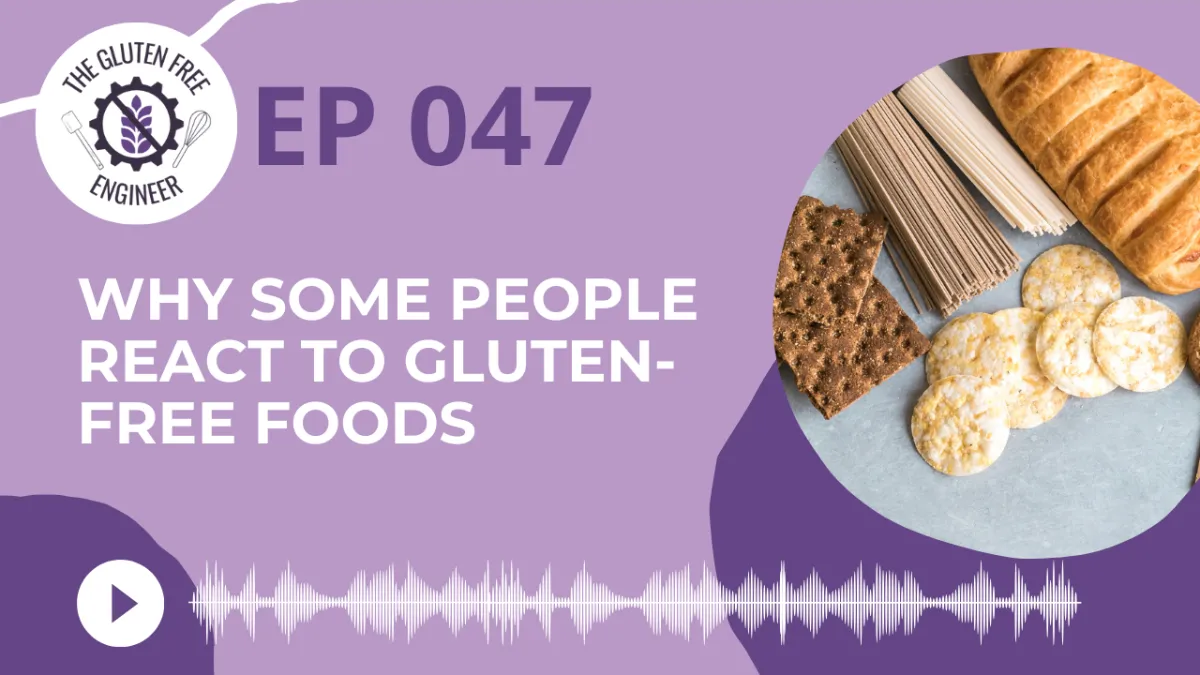
#47: Why Some People React to Gluten-Free Foods
You’ve gone gluten-free, but something still isn’t right. You’re doing everything ‘by the book,’ avoiding gluten completely — and yet, you’re still bloated, tired, or having reactions.
So what’s going on?
In today’s episode, we’re diving into why some people react to gluten-free foods — even when they’re technically safe. I’ll break down common triggers, what to look out for on ingredient labels, and how to start figuring out what your body’s really trying to tell you.
And stick with me until the end, because I’ll share the one surprising food that caused me major symptoms even though it was totally gluten-free.
Let's Recap: Why Some People React to Gluten-Free Foods
Many people remove wheat, barley, and rye only to find the same old bloat, fatigue, or brain fog. The reason often hides in two places: invisible cross-contamination and cross-reactive or high-FODMAP foods your immune system mistakes for trouble. Understanding both can save months of frustration.
Hidden sources and label realities
Start with labels and manufacturing facts. Oats grown near wheat or processed on shared lines can carry enough gluten to trigger symptoms. “Made in a facility with wheat” is a red flag for highly sensitive bodies. Certified gluten-free helps, but even then your immune system may react to similar proteins in corn, millet, sorghum, or dairy.
Cross-reactivity, lectins, and how similar proteins can cause symptoms
Cross-reactivity is real. Some bodies confuse non-gluten proteins or lectins for gluten, producing the same cascade: bloating, pain, sluggishness, headaches. Corn in grain form can stall digestion. Oats may raise baseline inflammation. Dairy type matters: A2 and grass-fed dairy can be easier for some people than conventional A1. Rice is not a free pass either; brown rice keeps the hull and more lectins, which irritate some guts, while white rice may be gentler. Add gums and fillers such as xanthan, guar, and tapioca, common in gluten-free baking, and you have another source of gas, cramps, and discomfort even in foods labeled “safe.”
FODMAPs and a short investigative reset
FODMAPs are fermentable carbs that feed your microbiome but can punish a healing gut. Chickpeas, lentils, inulin-heavy flours, onions, garlic, and fruits like apples can balloon into pain. A short, structured low-FODMAP reset can be powerful, not as a permanent diet but as an investigation. Two to six weeks of careful removal, followed by methodical reintroduction, reveals what is actually driving symptoms. Cooked fruit often lands better than raw; for example, an apple pie may sit better than a raw apple because heat breaks some fibers down. Small levers like this add up to big wins when you need energy for work, parenting, or training.
Track, test, and interpret the data
The most practical tool is a tight food-and-symptom journal. Track brands, ingredients, cooking methods, and timing. Some reactions are delayed by 24 to 48 hours, so watch patterns across days, not just meals. Choose your method: remove one suspected trigger at a time, or go broad with a low-FODMAP-plus strategy and add favorites back slowly. Space reintroductions by five to seven days. If your symptoms are severe or complex, work with a dietitian who understands celiac disease, non-celiac gluten sensitivity, and FODMAP science. Precision beats guesswork, and a skilled guide can compress timelines from months to weeks.
Practical eating for healing
Healing the gut asks for calm inputs. Prioritize whole, naturally gluten-free foods: lean proteins, cooked vegetables, tolerated fruits, and simple starches like white rice or well-rinsed quinoa if those work for you. Hydrate consistently and scale fiber to tolerance; vegetable fiber may sit better than legumes or grain fibers in the early stages. Limit ultra-processed gluten-free swaps until your symptoms settle. When you test reintroductions, choose single-ingredient foods, consistent portions, and keep life variables steady so the data is clean. Plan “known reaction meals” when your schedule can absorb a rough day. Choice is power.
Expect surprises and aim for a customized menu
Nightshades such as tomatoes can trigger headaches, congestion, or gut distress despite being naturally gluten-free. If a beloved food keeps correlating with symptoms, take a structured break and observe. The goal is not a shrinking menu but a customized one that lets you live, travel, and celebrate with less fear and more confidence. Over time, as inflammation falls and the gut lining repairs, tolerance may improve.
Use engineering thinking to guide recovery
Define the problem, control variables, test systematically, and iterate. Track the data and let your body’s signals point the way to a calmer, clearer, gluten-free life.
